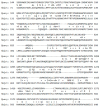Learning in the Single-Cell Organism Physarum polycephalum: Effect of Propofol
- PMID: 37047260
- PMCID: PMC10094176
- DOI: 10.3390/ijms24076287
Learning in the Single-Cell Organism Physarum polycephalum: Effect of Propofol
Abstract
Propofol belongs to a class of molecules that are known to block learning and memory in mammals, including rodents and humans. Interestingly, learning and memory are not tied to the presence of a nervous system. There are several lines of evidence indicating that single-celled organisms also have the capacity for learning and memory which may be considered as basal intelligence. Here, we introduce a new experimental model for testing the learning ability of Physarum polycephalum, a model organism frequently used to study single-celled "intelligence". In this study, the impact of propofol on Physarum's "intelligence" was tested. The model consists of a labyrinth of subsequent bifurcations in which food (oat flakes soaked with coconut oil-derived medium chain triglycerides [MCT] and soybean oil-derived long chain triglycerides [LCT]) or propofol in MCT/LCT) is placed in one of each Y-branch. In this setting, it was tested whether Physarum memorized the rewarding branch. We saw that Physarum was a quick learner when capturing the first bifurcations of the maze; thereafter, the effect decreased, perhaps due to reaching a state of satiety. In contrast, when oat flakes were soaked with propofol, Physarum's preference for oat flakes declined significantly. Several possible actions, including the blocking of gamma-aminobutyric acid (GABA) receptor signaling, are suggested to account for this behavior, many of which can be tested in our new model.
Keywords: Physarum polycephalum; anesthetics; learning; memory; propofol; single-celled organism.
Conflict of interest statement
The authors declare no conflict of interest.
Figures




Similar articles
-
[Comparison of propofol LCT and propofol MCT/LCT regarding the injection pain at different sites and the memory].Masui. 2005 Nov;54(11):1241-6. Masui. 2005. PMID: 16296361 Japanese.
-
Effects of different preparations of propofol, diazepam, and etomidate on human neutrophils in vitro.Acta Anaesthesiol Scand. 2001 Feb;45(2):213-20. doi: 10.1034/j.1399-6576.2001.450213.x. Acta Anaesthesiol Scand. 2001. PMID: 11167168
-
Direct assessments of the antioxidant effects of propofol medium chain triglyceride/long chain triglyceride on the brain of stroke-prone spontaneously hypertensive rats using electron spin resonance spectroscopy.Anesthesiology. 2008 Sep;109(3):426-35. doi: 10.1097/ALN.0b013e318182a903. Anesthesiology. 2008. PMID: 18719440
-
Does being multi-headed make you better at solving problems? A survey of Physarum-based models and computations.Phys Life Rev. 2019 Jul;29:1-26. doi: 10.1016/j.plrev.2018.05.002. Epub 2018 May 22. Phys Life Rev. 2019. PMID: 29857934 Review.
-
Thoughts from the forest floor: a review of cognition in the slime mould Physarum polycephalum.Anim Cogn. 2023 Nov;26(6):1783-1797. doi: 10.1007/s10071-023-01782-1. Epub 2023 May 11. Anim Cogn. 2023. PMID: 37166523 Free PMC article. Review.
Cited by
-
The "plant neurobiology" revolution.Plant Signal Behav. 2024 Dec 31;19(1):2345413. doi: 10.1080/15592324.2024.2345413. Epub 2024 May 6. Plant Signal Behav. 2024. PMID: 38709727 Free PMC article. Review.
References
MeSH terms
Substances
LinkOut - more resources
Full Text Sources

